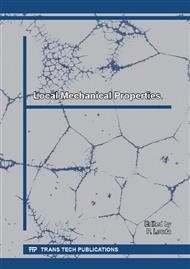p.158
p.162
p.166
p.170
p.174
p.178
p.182
p.186
p.193
Young’s Modulus of Alumina Particles Reinforced Metal-Matrix Composite
Abstract:
Young’s modulus of alumina particles reinforced pure Al-matrix composite is characterized by different methods: the pulse-echo ultrasound method, static three point bending, resonant bending and continuous multicycle measurement by instrumented indentation. Dependency of apparent Young’s modulus on loading amplitude was observed and attributed to the local mechanical properties of both phases, especially to the development of internal damage (local plasticity and particle cracking).
Info:
Periodical:
Pages:
174-177
Citation:
Online since:
July 2016
Price:
Сopyright:
© 2016 Trans Tech Publications Ltd. All Rights Reserved
Share:
Citation:


